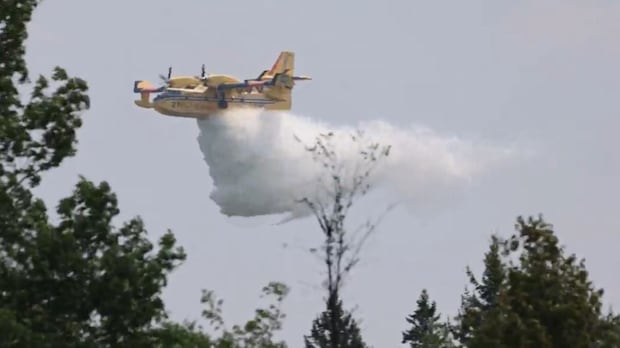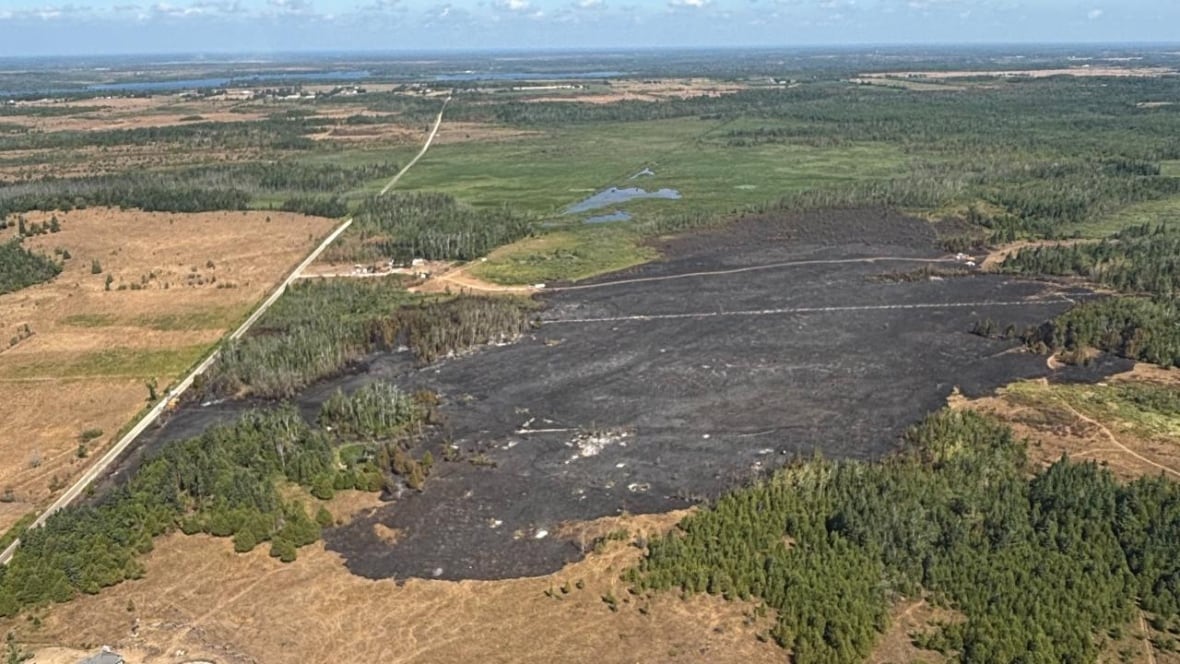Fire crews in Kawartha Lakes are battling a fourth active forest fire on Tuesday, the Ministry of Natural Resources says.
The OFR001 fire, began Monday afternoon as a grass fire and was five hectares in size, said a release from the city. It has since grown to about 35 hectares, said a fire information officer with the Ministry of Natural Resources in a news conference Tuesday.
“The fire is not under control,” said Evan Lizotte. “Personnel from the Haliburton Fire Management Headquarters are responding to the fire with five fire ranger crews and air attack.”
No evacuation necessary for now: mayor
The fire is located about 200 metres east of Prospect Road and one kilometre north of Eldon Station Road in the Kirkfield area.
During the Tuesday news conference, the mayor of Kawartha Lakes said roads are closed in the area of the fire until further notice.
“At this time, there’s no evacuation necessary. Residents and visitors are urged to avoid the two fire areas to allow crews to safely continue their work and move out with ease and as rapidly as possible,” said Doug Elmslie.
Elmslie said the city has resources available and community centre and public buildings that could be used should that change and an evacuation become necessary.
WATCH | Residents worry as fires rage in Kawartha Lakes: 
Residents worry as wildfires rage near Kawartha Lakes
From ice storms to wildfires, residents in Kawartha Lakes have faced several environmental challenges this year. As CBC’s Dale Manucdoc reports, people are worried the flames may soon spread to their homes.
Emergency responders were first alerted to the grass fire when smoke was spotted in Kirkfield on Monday afternoon, said Ontario Provincial Police (OPP) on social media.
Fire crews, water bomber planes and a helicopter worked to suppress the new fire on Monday.
“Farms are actively moving their animals to safety. Please avoid the area,” said the OPP post.
Crews also battling 3 other active fires in the area
The city’s release said extremely dry conditions and four active fires are straining firefighting resources in the area.
Kawartha Lakes is currently facing three other active fires. Of those fires, it says HAL018 and HAL019 are out of control, while HAL016 is under control.
As of Tuesday morning, HAL018 is over 12 hectares and HAL019 is approximately 27 hectares
 Picture of the OFR001 fire area taken from a Ministry of Natural Resources flight on Tuesday. (City of Kawartha Lakes)
Picture of the OFR001 fire area taken from a Ministry of Natural Resources flight on Tuesday. (City of Kawartha Lakes)
Lizotte says both fires have “been tied in,” meaning the crews have managed to prevent the fire from advancing further by keeping it contained.
If residents spot any smoke, they’re asked to call 705-324-2191 instead of 911, said city officials.
A citywide total fire ban is in place. People are also requested to not fly their drones within nine kilometres of the fire for safety reasons.
“There will be zero tolerance for burning. Please don’t operate any drones near the active fire scenes because it could interfere with those aerial operations, and it is also illegal and poses a serious risk,” said Elmslie.
Ice storm damage impacting firefighters’ efforts
Elmslie said the ice storm that hit Kawartha Lakes at the end of March has left an impact on firefighters’ efforts.
“The ice storm at the end of March was quite devastating for our community, to the trees in the forest, the crowns of the trees, a lot of the trees came down, and of course that creates brush on the ground,” he said.
He says crews battling the fires tell him that the debris on the ground is making it harder for them to walk through the forest and reach the fires.
“They can’t actively access it. It is very difficult for them,” said Elmslie
The city declared state of emergency in late March as thousands of residents were without power due to the ice storm.
What should residents do with fires coming closer to cities?
It’s imperative for residents to know how to fireproof their homes and communities, said Vinny Gupta, an assistant professor in fire safety engineering at the University of Waterloo.
“What we’re seeing is wildfires get closer and closer to big cities and I don’t think these problems are going to go away,” he told CBC Radio’s Metro Morning.
Looking at the wildfires that took over residential areas around Los Angeles in early 2025, Gupta said these issues should be more seriously considered by government officials.
Currently local municipalities in Ontario drive guidelines for wildfire proofing and design, but Gupta says federal and provincial governments should be part of that effort.
“One of the key challenges is that we already have a lot of homes and buildings in Ontario, so we need to come up with fast solutions to retrofit … where we can fireproof them,” he said.
The OFR001 fire in the Kirkfield area began on Monday afternoon and is about 35 hectares in size, said the Ministry of Natural Resources. (Paul Smith/CBC)
People should regularly clear yards and gutters for flammable materials and consider what their fences and decks are made of, he said.
Fire ban in effect for Vaughan
While crews battle the fire up north, the city of Vaughan has issued a fire ban on all outdoor and open-air burning, effective on Tuesday, in response to the ongoing dry and hot weather conditions.
The city said in a release Tuesday that the ban includes prohibiting the use of outdoor wood-burning appliances, like fire pits, fireplaces, bonfires, chimineas, and campfires, until further notice. The ban does not apply to cooking appliances, but residents are encouraged to take precautions.
Vaughan Fire and Rescue Service will continue to monitor weather and air quality conditions, and updates will be posted at vaughan.ca, the city said.
Existing fire permits are cancelled, no new fire permits will be issued, and open fires or burning debris of any kind are not permitted until the ban is lifted, the city said.
Oshawa, Newmarket and Aurora have also implemented fire bans.